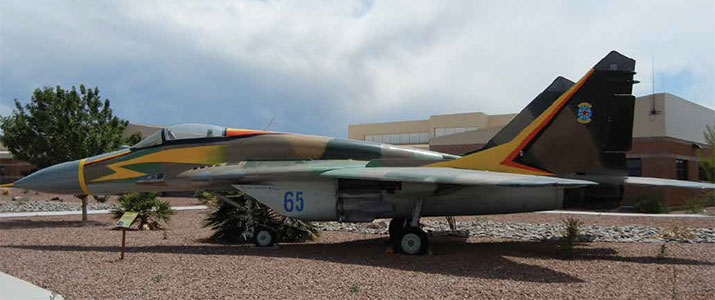
All Flights Go
Mass notification capabilities brought to Air Force 64th and 65th Aggressor Squadrons
- By Mike Madden
- Jun 01, 2013
 Several miles outside Las Vegas, Nellis Air Force Base serves as
the home and major training site for two historically significant
flying units: the 64th and 65th Aggressor Squadrons. During the
Cold War, this group of highly-trained pilots flew an assortment
of Russian-made MiG aircraft to decipher the actions of the Air
Force’s potential enemies.
Several miles outside Las Vegas, Nellis Air Force Base serves as
the home and major training site for two historically significant
flying units: the 64th and 65th Aggressor Squadrons. During the
Cold War, this group of highly-trained pilots flew an assortment
of Russian-made MiG aircraft to decipher the actions of the Air
Force’s potential enemies.
Post Cold War, some of the threats have changed, but the squadrons’ mission
remains the same—to master the tactics of foreign air forces. The rising threat
of terrorism targeted at highly-secure facilities, such as Nellis AFB, has posed a
challenge in implementation of an effective mass notification solution. To provide
guidelines for the design and installation of mass notification systems (MNS) on
its military installations, the Department of Defense created Unified Facilities Criteria
(UFC) document 4-021-01.
A Design Issue
The original project design was for an expansion to the existing 65th Aggressor
Squadron (AGRS) facility to house the 64th AGRS squadron. However, during a
site visit Nellis AFB fire inspectors noticed the common parapet wall had openings
not compliant with International Building Code (IBC) and the DoD’s latest version
of UFC 3-600-01: Fire Protection Engineering for Facilities. The height of the
wall did not extend beyond the roof level and was not adequate to adhere to the
four-hour separation requirement as stipulated by IBC, Section 705.6. This created
the contiguous space requirement of integrating a fire alarm and MNS from
two separate systems into one. In addition, the project was greatly complicated by
the various security measures both squadrons use to protect secret information
within a number of highly-secure areas that are physically protected and electronically
isolated.
According to Lt. Col. Kevin Wilson of the 64th AGRS, the evolution of the
squadrons’ facilities from separate structures to one building with a shared common
wall posed a problem for the design of effective systems for fire alarms and
mass notification.
“It was a unique situation in terms of the mission that our two squadrons do,”
Wilson said. “At another Air Force base they probably wouldn’t operate as closely
as the 64th and 65th .
“That was the real pain in the neck; we had to stay both within the letter and
spirit of the law in terms of transmitting devices inside a secure area, yet we wanted
to be able to get notices as well as mass notification messages to those working
inside the security vault.”
Designing and installing one combination fire alarm and MNS that could
work for two semi-separate structures would pose a challenge.
A Combined Solution
Preferred QC is a company that provides quality control management services to
general contractors working with the government. The company’s president, Michelle
Hanks, has worked with Nellis AFB on various projects for nearly a decade
and consulted on the 64th and 65th Squadrons’ building project from start to finish.
“This was an Army Corps of Engineers design and they originally envisioned
it as a standalone fire alarm system for each side,” Hanks said. “So if I pulled an
alarm in the 64th side, it wouldn’t work on the 65th side. We knew right away that
was an issue.”
Originally, the 65th consisted of separate systems for fire alarm and mass notification.
The setup of the MNS also provided little day-to-day benefit, since the system
was not user-friendly and access was greatly restricted for emergency use only.
After less than a year in service, the original fire alarm system started to degrade.
“The existing system had a bad history of false alarms, initiating strobe alarms
and even interrupting secure briefings. It also had relatively limited functionality
compared to more modern systems,” said Brian Stuart, president of Aberdeen
Technologies, a low-voltage systems integrator from the Las Vegas Valley.
“Aberdeen had said they could integrate the whole system as one,” Hanks said.
“That seemed to be the best solution, namely taking out the old (systems) and putting
in something entirely new for both facilities.”
Aberdeen Technologies recommended the old system be replaced with a
Gamewell-FCI E3 Series combination fire alarm and mass notification system that
serviced both buildings.
“That decision ended up resolving a lot of issues,” Brian Stuart said.
Multi-Purpose Communications
As the project advanced, Aberdeen Technologies had to integrate the systems protecting
both squadrons to route emergency messages throughout the facility, while
providing each side with control over routine messages.
“As it is presently configured, an alarm triggered by smoke, for example, would
sound in both squadron areas, but management from moment to moment is controlled
within each squadron,” Brian Stuart said.
Aberdeen’s field supervisor, Brendyn Stuart, and his team provided thorough
instruction to squadron personnel on the operation of their new MNS.
“I gave them a key to the system and said this is how you use it, with warnings
for intruders, weather conditions, evacuations, and so on,” Brendyn Stuart said.
When Brendyn Stuart explained the operation of the system’s microphone for
live paging, a vast change in the squadrons’ attention was noted as they realized
this could serve as a supplemental PA system for internal communications.
“Before you knew it, they were using it all the time,” Brendyn Stuart said.
Wilson credits the E3 Series’ paging feature for enabling the two squadrons to
frequently share resources.
“The ability to use this mass notification system as a PA system to call people
was really helpful in terms of efficiency,” Wilson said. “It enabled us to work together
effectively, and in the long-term it really saved us manpower.”
“The idea of integrating the MNS into the squadrons’ daily routine will give
confidence and ensure the proper use of the system in a real-world scenario, possibly
eliminating or mitigating injuries or loss of life,” Brian Stuart said.
Monitoring and Networking Ingenuity
Two remote annunciators and six local operating consoles placed throughout the
facility provide occupants and first responders—firefighters and police—immediate
access to information and control of the entire fire alarm and MNS network.
Designed to meet the strict specifications of the UFC, each LOC from Gamewell-
FCI is comprised of a network graphic annunicator (NGA), microphone and 16
programmable switches. The NGA allows users to view real-time system status
and event information from the entire network on a touch-screen, LED display
created to mimic the intuitive operation of an ATM. The microphone facilitates
live-voice announcements while the LOC’s 16 switches can be programmed to either
send out specific emergency notifications or to control which building zones/
areas receive notifications.
As Brian Stuart discovered, each squadron has a number of Sensitive Compartmented
Information Facilities (SCIFs) in which classified material is handled.
To ensure electromagnetic isolation, each SCIF could only be connected to the
“outside” world via fiber-optic technology, which had been a problem for the older
fire alarm and MNS that ran their audio circuits on copper wire and other ad
hoc solutions. The facility’s new E3 Series fire alarm and MNS requires only two
strands of fiber-optic cable for both alarm signaling and audio, which satisfied the
facilities’ security requirements and eliminated the mass of conduit and wire typically
used to support two separate systems.
“The big splash is how it is structured, as a combined fire alarm and mass notification
system,” Brian Stuart said. “It is networked using fiber interconnects that
will penetrate into and out of those SCIF-rated areas. In addition to meeting security
requirements, the use of fiber-optic cable also makes the system more resistant
to catastrophic failure due to lightning strikes.”
Survivability, one of the UFC document’s essential qualities for a combined fire
alarm/MNS such as this, is a result of the E3 Series’ distributed communications
architecture.
“If the fiber was severed in one location, the alarms and messages will still
travel through the network to where they are needed,” Brian Stuart said. “In fact,
the routing of the fiber cable in a class-X, fully redundant fashion to serve both
sides of the building actually provides better survivability, command and control.
This is what true peer-to-peer systems architecture is all about.”
“I have never seen a building fire alarm or mass notification system with such
sophistication, where it met our needs as far as the safety aspect,
but also had the ability to let people communicate about other
issues,” Wilson said. “I definitely think our experience should be
shared, especially in terms of any kind of cross-mission design.
We should all learn from this lesson.”
This article originally appeared in the June 2013 issue of Security Today.